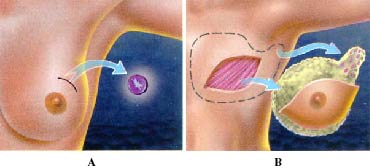What to Know About Surgery for Breast Cancer
The Goal of Breast Cancer Surgery
Surgery is the most common treatment for breast cancer. The goal of surgery is to remove the cancer from the breast and from any areas where it may have spread.
Types of Breast Cancer Surgery
The following types of surgery may be used, depending on the type of breast cancer you have. There are surgeries for the lymph nodes, surgeries for the breast, and reconstructive surgery.
You and your doctor can talk about and compare the benefits and risks of each type of surgery. Your doctor can also describe how each treatment will affect the way you’ll look afterward. Each of these types of surgery may or may not require additional types of treatment. When you have another treatment after your first treatment, it’s called adjuvant therapy.
Sentinel Node Biopsy
If breast cancer spreads, it usually spreads first to the lymph nodes under your arms. The sentinel lymph node is the node it reaches first. In this surgery, the sentinel node is identified and removed to see if it has cancer cells in it. If the sentinel node doesn’t have cancer, then the rest of your underarm nodes have a very good chance of being cancer-free. Therefore, this kind of biopsy can save you from having the rest of your nodes taken out. Sentinel node biopsy is often followed by breast-conserving surgery or a mastectomy.
Sentinel lymph node biopsy requires a great deal of surgical skill. If your doctor thinks you should have this type of biopsy, ask if the surgical team who will do the procedure has experience and does them regularly.
Breast-Conserving Surgery
This type of surgery is also called breast-sparing surgery, lumpectomy, partial mastectomy, or segmental mastectomy. The surgeon takes out only the lump and some surrounding tissue.
Mastectomy
For this surgery, the surgeon removes one or both of your breasts. There are three main types of mastectomies:
-
Total mastectomy (also called a simple mastectomy). This type removes your whole breast and often the lining over your chest muscle.
-
Modified radical mastectomy. This type removes your whole breast, most of the lymph nodes under your arm, and often the lining over your chest muscles. Sometimes your doctor has to remove one of your two chest muscles.
-
Radical mastectomy (also called a Halsted radical mastectomy). Your doctor may do this in rare cases. For this surgery, the surgeon removes both of your chest muscles as well as those tissues removed in a modified radical mastectomy.
A skin sparing technique may be an option for some women planning immediate reconstruction. In this surgery, most of the skin over the breast (except the nipple and areola) is left intact, and the same amount of breast tissue is removed, as with a total mastectomy.

Reconstructive Surgery
This is surgery to rebuild your breast mound or shape after a mastectomy. You can opt for reconstructive surgery using artificial implants, or you can choose to have surgery that rebuilds your breast shape using tissue from another part of your body. That tissue can come from your back, abdomen (belly), or buttocks. Reconstruction can be done at the same time as the mastectomy or sometime later. The four main kinds of reconstructive surgery include the following:
-
Implants. Most often, a saline-filled implant is used. It's a silicone shell filled with salt water (saline). Silicone gel-filled implants can also be used.
-
Implant with latissimus dorsi reconstruction. This surgery uses an implant and moves muscle, fat, and skin from your upper back when extra tissue is needed.
-
Transverse rectus abdominus muscle (TRAM) flap. This procedure uses tissue and muscle from the tummy to shape the breast and an implant may not be needed.
-
Free flap. This requires the use of a microscope to connect blood vessels to a flap of skin, fat, and muscle that has been cut free of its original location, which is often the belly, buttocks, or inner thighs.
Schedule a Mammogram at Richmond University Medical Center
Early detection and treatment is the best strategy for a better cancer outcome. Schedule your mammogram at RUMC: Call 718-818-3280.
Kathy Giovinazzo is Director of Radiology at Richmond University Medical Center.
For More Information
For more information or to schedule an appointment, contact Dr. Thomas Forlenza at 718-816-4949. His office is located at 1366 Victory Blvd on Staten Island.
Dr. Forlenza is the Director of Oncology at Richmond University Medical Center.